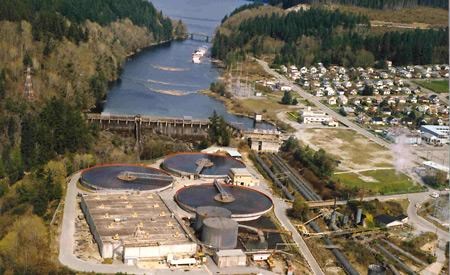A new report that could become the City of Powell River’s draft stage three liquid waste management plan (LWMP) proposes phased consolidated treatment. That option combines co-treatment, a proposal to treat the city’s sewage at Catalyst Paper Corporation’s Powell River mill, with a stand-alone consolidated plant to be built sometime in the future.
City officials presented the report, prepared by Opus Dayton and Knight, at joint local-technical advisory committee (JAC) and steering committee meetings last week. The report is potentially the draft LWMP that will be submitted to the ministry of environment for approval.
Council approved a phased consolidated treatment option as the preferred choice for liquid waste management, subject to a long list of conditions, at a special council meeting on June 27, 2011. The first condition was that the city’s grant application to the BC Innovation fund for 100 per cent funding for co-treatment was successful. The city was informed in December 2011 that it was not successful. As well, Catalyst entered bankruptcy protection in early 2012, which quelled any further discussion about co-treatment.
However, city staff met with ministry officials toward the end of 2012. Subsequently, Dayton and Knight began work on the new report. It updates the costs for co-treatment, with pre-treatment facilities located at the existing Townsite wastewater treatment plant, for an estimated cost of $5.2 million to $6.4 million. A consolidated plant would then cost about $15.4 million to construct.
Mac Fraser, the city’s chief administrative officer, said at the steering committee meeting that Kevin Clarke, Catalyst’s president and CEO, said during a recent meeting with council that the mill continues to look positively toward co-treatment, but the “devil is in the details.” As the process proceeds, Fraser said, the city would ask Catalyst and Tla’amin (Sliammon) First Nation for letters of agreement and support.
Fraser also took a moment to acknowledge Sarah Barkowski, the mill’s environmental manager. “At the end of the JAC last night, I suggested to Sarah that maybe I should be paying her,” he said. “It’s a strong partnership before we even sign anything.”
Councillor Russell Brewer raised a question about the first condition in council’s 2011 resolution, a successful grant application. “That begs the question whether this is still a valid motion, in my mind,” he said. “I’ve heard lots of comments that phased co-treatment wouldn’t happen unless we got this grant.”
Councillor Jim Palm, chair of both the JAC and steering committees, explained that ministry officials have said there would not be any grant funding available without an approved LWMP.
It’s very unusual for a sewage treatment construction project to be funded without an approved liquid waste management plan, Fraser said. “With all respect to the intent there, it was a little bit out of order,” he said. “I take that, as the senior staff member, as the direction to proceed on, but not that that is an automatic go for a decision of stage three.”
At both meetings, Fraser outlined the economic benefits of choosing co-treatment. He pointed out a consolidated facility would cost about $27 million. Piping to connect the pre-treatment facility to Catalyst’s system would cost about $1 million and would not be used in the consolidated plant, once it is built. “The million dollars that has to be spent to make the connect for co-treatment, and then becomes redundant when you go to a consolidated plant, is less than [what] you would pay for debt servicing if you went to a consolidated plant as soon as possible and projected that out in its first 10 years,” he said. “The co-treatment option you are considering...is putting in place a potential for 20 years of deferring phase two costs of $15 to $16 million.”
Brewer asked what happens if the mill shuts down. Fraser said the ministry is expecting a commitment from Catalyst to give sufficient notice for end of service so the city could reasonably have time to consider and build the consolidated plant.
There is only one phase of public consultation left for the city to complete, reporting back to the community on council’s decision. There was no discussion about a referendum, a promise that some elected officials made before the November 2011 local government election.
Click to view the engineering report and a summary of the report.



